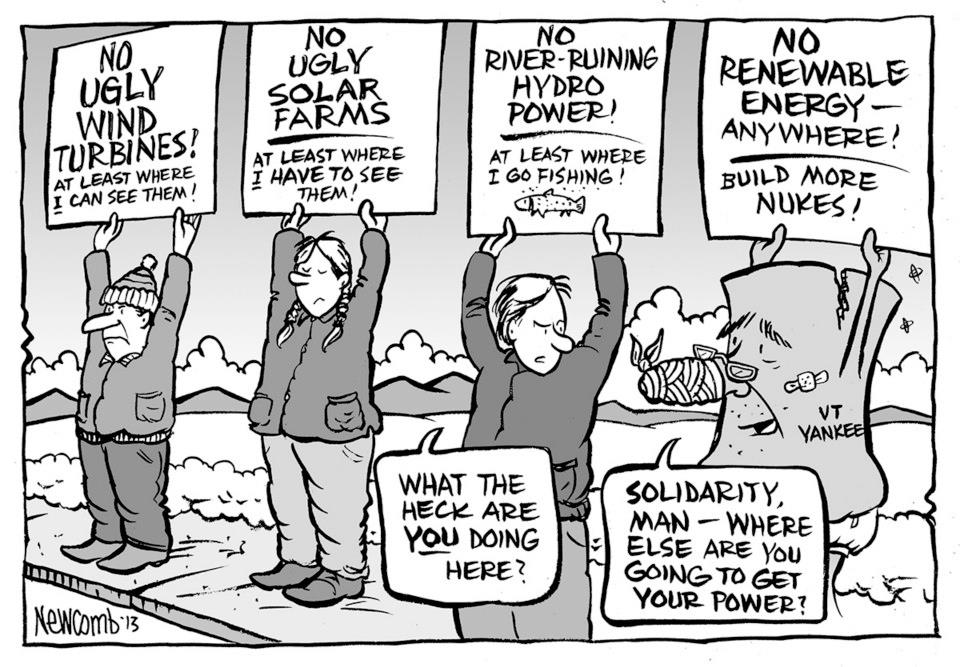For immediate release: January 31, 2013
Montpelier — We welcome today’s plan from Energize Vermont. Having a plan of their own to promote and defend is the first step toward becoming a credible player on energy policy matters in the state.
Now attention will turn to the specifics of their plan. It’s no longer enough for Energize Vermont or its allies to simply say no to wind or any other power source. Now they will own the plan they have put forward, including all of the environmental and public health implications of the energy mix they embrace.
Outlined below are some of the most significant problems with their plan:
Hydro Quebec is a massive power source that has generated tremendous controversy over the years as it diverted rivers, flooded hundreds of thousands of acres, forced the relocation of native populations, destroyed wildlife habitat and required the construction of huge new power lines. It is of course located in another country, and is owned by a very large corporate entity. Many people concerned about wind power in Vermont have expressed grave reservations about depending on large corporate entities from Canada for our power. It would also be the height of hypocrisy for an anti-wind group in Vermont to suddenly embrace increased reliance on a power project as large and damaging as HQ.
Another major problem with dramatically increasing the load we get from HQ is the fact that it would require major transmission line upgrades in Vermont. The transmission lines in the NEK are essentially maxed out right now, which is a point wind opponents, including Energize Vermont, have made many times as one of their main concerns about siting additional wind resources in that part of the state.
Is Energize Vermont unconcerned about the natural resources implications of HQ? Is Energize Vermont no longer interested in generating the maximum quantity of power as close to where it will be used as possible? Is the issue of transmission line upgrades no longer relevant to Energize Vermont?
We understand that nuclear power from Seabrook is contractually part of the state’s energy mix through 2035 at this point. Will Energize Vermont join us in opposing any further contracts for nuclear power? Does Energize Vermont support the immediate and permanent closure of Vermont Yankee?
In 2035, when the contract with Seabrook has expired, where will Energize Vermont get the 7% power they have coming from nuclear in 2030?
Regarding electric vehicles, VPIRG’s long-term energy plan produced in 2009 projected that pure electric and plug-in hybrid vehicles would require an additional 2,100 GWh of electricity capacity by 2032, based on the total number of miles driven by Vermonters each year. Energize Vermont’s plan for 2030 is much less ambitious, but it is still unrealistic to think that 110,000 plug-in electric vehicles will require no additional electricity capacity. This is a major flaw in the plan, especially given Energize Vermont’s stated interest in prioritizing transportation issues. Energize Vermont’s goal for 110,000 electric vehicles in 2030 also fails to meet the electric vehicle goal called for in Vermont’s Comprehensive Energy Plan.
Beyond these significant questions and concerns, we note that Energize Vermont appears willing to accept the power currently being generated by in-state wind resources. But where would Energize Vermont have gotten this significant quantity of power if they had prevailed in preventing these wind projects from being built? And if Energize Vermont supports only a 3-year moratorium, why does the plan include no wind development after that? Is a ban on local wind what Energize Vermont is really advocating? Energize Vermont also suggests that it will consider wind resources from outside Vermont if additional resources are necessary. This is the definition of Not-In-My-Backyard, and is indefensible from an environmental standpoint.
The quantity of power that Energize Vermont projects coming from local hydro projects is high. This will require new plants and retrofits of existing facilities. The new plants in particular will bring natural resource and habitat impacts that must be seriously considered.
The plan has nearly 10% of the power still being purchased from the New England market, which means a heavy reliance on natural gas and other fossil fuels. That gas is increasingly the result of fracking, a process so dirty, dangerous and polluting that Vermont banned it a year ago.
The total solar projections are not unreasonable, but the details of the plan are problematic. We note that Energize Vermont has apparently moved away from its earlier embrace of Professor Ben Luce’s wildly unrealistic projections for solar energy in the near term in Vermont. Credit goes to Energize Vermont for disassociating itself from Mr. Luce’s scheme.
The bottom line is that Energize Vermont is now in the game with a plan that would rely heavily on large hydro and fossil fuel power generated out of state, result in significant new natural resource damage in Vermont and continue our reliance on nuclear power. It’s also flawed in that it projects being able to power more than 100,000 vehicles with no additional electricity capacity.
For Vermonters interested in taking responsibility for their energy future by generating as much clean energy as possible close to home, this plan is not it. Forcing others to bear the burden of producing the power we use every day while refusing to develop renewable resources readily at our disposal is neither morally courageous nor environmentally responsible leadership.
# # #

